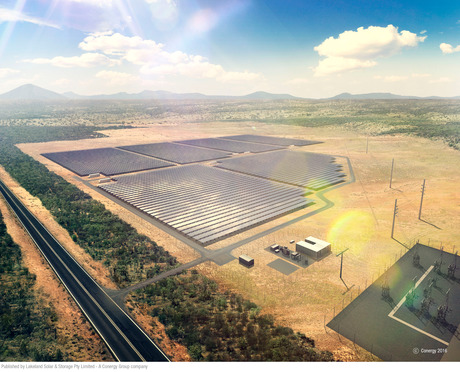Solar and storage in regional Queensland

Downstream solar company Conergy will soon begin construction of an Australian solar and storage project, designed to consistently feed renewable energy into the grid and demonstrate the capability for large-scale solar and storage to provide reliable future power quality and supply at a fringe-of-grid location.
The $42.5 million initiative will be supported by $17.4 million from the Australian Renewable Energy Agency (ARENA), whose CEO, Ivor Frischknecht, said the large-scale combination of solar PV and battery storage technologies will “be crucial for helping more renewables enter our grids”.
“We know that battery storage will play a critical role in our future energy systems,” Frischknecht said. “The benefit of adding batteries to solar farms is simple — they store energy from the sun for use at peak times and overnight. They can also smooth solar energy output on cloudy days.”
The project, to be constructed on a 50 ha site at Lakeland in Far North Queensland, will consist of a 13 MWp/10.8 MWac solar power PV ground-mounted array (featuring 41,440 solar panels), with a 1.4 MW/5.3 MWh Conergy ‘CHESS’ storage solution. Set to produce enough electricity to power the equivalent of over 3000 homes day and night, it is said to be the Southern Hemisphere’s first integrated solar, storage and fringe-of-grid project of this size and scale.
The project will connect to Ergon Energy’s existing substation — one of the most remote National Electricity Market-connected substations in Australia. A detailed battery testing plan will be implemented over the first two years of operations, culminating in testing ‘island mode’ during the evening peak.
“This project is aiming to be the first in the world to test a concept known as ‘islanding’ from the main electricity grid,” said Frischknecht. “The local town of Lakeland will be powered solely by solar and batteries for several hours during these tests.”
Conergy Managing Director David McCallum said there is an immense opportunity for the widespread use of utility-scale batteries to store surplus power from excess solar generation for use during cloud cover, night-time and peak times, thus limiting and decreasing future demand on traditional generation and transmission infrastructure.
“We want to demonstrate how this technology can provide an effective and consistent supply to the grid or operate in islanding mode, particularly in fringe-of-grid locations, paving the way for this integrated model to be used more widely around the world,” he said.
Due to the project’s potential learnings, a knowledge sharing program (KSP) has been established between Conergy, ARENA, BHP Billiton, Ergon Energy and Origin Energy. McCallum noted, “BHP Billiton will gain valuable insights into the potential for solar and storage to assist its remote operations, Ergon is considering if the approach could help avoid network upgrade costs in other regional Queensland communities and Origin is buying the power from the plant.”
The construction program will begin at the end of August, with civil and mechanical works, and is expected to be completed by April next year. Up to 50 people will be working on-site during construction, with up to 10 people involved in the ongoing operation of the project during its expected lifespan of more than 20 years.
“Utility-scale solar and storage, combined with effective management software, is the Holy Grail of the global renewable energy industry, and with this project we are well within reach of it,” McCallum said.
Sustainable organic batteries for future energy storage
A rechargeable proton battery being developed by scientists at UNSW Sydney has the potential to...
CSIRO's solar venture secures $15 million funding
FPR Energy, a new venture from CSIRO, has secured $15 million in seed funding.
Aust partnership leads to solar-powered canola
Riverina Oils, a NSW canola oil producer, has partnered with Australian renewable energy retailer...







